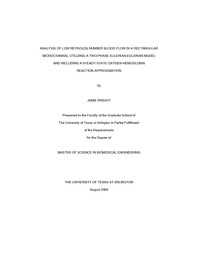
ATTENTION: The works hosted here are being migrated to a new repository that will consolidate resources, improve discoverability, and better show UTA's research impact on the global community. We will update authors as the migration progresses. Please see MavMatrix for more information.
Show simple item record
| dc.contributor.author | Wright, Jamie | en_US |
| dc.date.accessioned | 2009-09-16T18:19:37Z | |
| dc.date.available | 2009-09-16T18:19:37Z | |
| dc.date.issued | 2009-09-16T18:19:37Z | |
| dc.date.submitted | January 2009 | en_US |
| dc.identifier.other | DISS-10347 | en_US |
| dc.identifier.uri | http://hdl.handle.net/10106/1763 | |
| dc.description.abstract | The evolution of oxygenator design has culminated in the current strategy of utilizing micro-porous membranes to separate blood and oxygen phases while utilizing extra-luminal blood flow orientations to promote passive and active secondary mixing of the blood to inhibit the build up of concentration boundary layers near oxygen transfer surfaces that impede efficiency. Advances in fabrication techniques could allow for the manufacturing of oxygenators employing microchannels to decrease the diffusion path between oxygen and the red blood cells, more closely mimicking the strategy employed by the body. Because blood is actually a complex suspension, it is difficult to model. Furthermore, as channel dimensions decrease below about 500 micometers, the particulate nature of blood becomes increasingly important. The Fahraeus effect and the Fahraeus-Lindquist effect indicate that blood flow in channels comprising dimensions smaller than this exhibit a decrease in hematocrit and apparent viscosity respectively within the microchannel as compared with the feed or discharge hematocrit or viscosity. Additionally, blood is a reactive fluid. Oxygen-hemoglobin binding increases the oxygen carrying capacity of the blood multifold. The objective of the this work was to develop a CFD model to simulate blood flow in a rectangular microchannel in order to predict the appropriate Reynolds number (Re) or range of Re's to achieve optimal O2 transfer into the blood. It was imperative to include both the particulate nature of blood and the oxygen-hemoglobin binding effects in the model especially within the proposed microchannel dimensions. Ansys CFX version 11.0 was employed to develop a Eulerian-Eulerian multiphase blood model consisting of a continuous plasma phase and a dispersed red blood cell phase, each possessing independent velocity fields and each phase interacting through friction drag forces. Oxygen diffusion and oxygen-hemoglobin reaction effects were included through the use of volumetric, scalar variables representing oxygen, hemoglobin, and oxyhemoglobin. Hemoglobin and oxyhemoglobin were limited to the dispersed red blood cell phase while oxygen was included as a component of both phases. Oxygen was allowed to transfer between phases as a function of the driving concentration gradient and a membrane resistance value quoted by previous experimenters. The oxygen-hemoglobin binding reaction was modeled using a non-linear source term in the red blood cell phase that adjusted oxygen, hemoglobin, and oxyhemoglobin concentrations to reflect saturation levels predicted by the Hill equilibrium curve which predicts hemoglobin saturation levels based on unbound oxygen concentrations. Simulations were conducted under 4 different velocity loads spanning Re from 0.2 to 9. A simplified passive Newtonian model was also employed under matching continuous phase velocity loads for comparison. The multiphase model exhibited attenuated hematocrit and apparent viscosity levels within the microchannel as predicted. In addition, the multiphase model showed an attenuated hydraulic resistance when compared with the Newtonian simulations. The oxygen-hemoglobin binding kinetics of the multiphase model led to increases in Sherwood numbers as a result of the hemoglobin sink maintaining higher driving concentration gradients. Flux to flow rate ratios (N/Q) indicated a peak volumetric gain in oxygen around a Re of 0.2. Furthermore there was up to a 5-fold increase in the volumetric addition of oxygen in the multiphase model as opposed to the Newtonian control. The model indicates that the microchannel might operate most efficiently under convective loads resulting in Re near 0.1 or 0.2. | en_US |
| dc.description.sponsorship | Chuong, Cheng-Jen | en_US |
| dc.language.iso | EN | en_US |
| dc.publisher | Biomedical Engineering | en_US |
| dc.title | Analysis Of Oxygen Uptake During Blood Flow Through A Rectangular Microchannel: A Two Phase Eulerian Model With Oxygen-hemoglobin Reaction | en_US |
| dc.type | M.S. | en_US |
| dc.contributor.committeeChair | Chuong, Cheng-Jen | en_US |
| dc.degree.department | Biomedical Engineering | en_US |
| dc.degree.discipline | Biomedical Engineering | en_US |
| dc.degree.grantor | University of Texas at Arlington | en_US |
| dc.degree.level | masters | en_US |
| dc.degree.name | M.S. | en_US |
| dc.identifier.externalLink | http://www.uta.edu/ra/real/editprofile.php?onlyview=1&pid=13 | |
| dc.identifier.externalLinkDescription | Link to Research Profiles | |
Files in this item
- Name:
- Wright_uta_2502M_10347.pdf
- Size:
- 4.812Mb
- Format:
- PDF
This item appears in the following Collection(s)
Show simple item record


